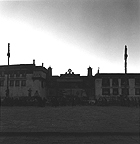


| The Jokhang, Tibetan
Buddhism's most sacred temple, stands broad and low in the heart of
old Lhasa, the recipient of prayers of daily worshippers and once-in-a-lifetime
pilgrims. These photographs are part of a project that documents the
kora, the sacred path of worship that circles the Jokhang.
From earliest dawn to last light, Tibetans arrive to make the circumambulation of the Jokhang to earn religious merit. Yet, the kora is also a residential area and a market, the heart of Lhasa where Tibetans live, meet, socialize and shop. Houses and stores fill the spaces between the smaller temples, prayer poles and prayer wheels. Broken only by intersecting alleys, the buildings transform the kora into an enclosed lane. All day long there is constant movement: a clock-wise flowing stream of worshippers, shoppers and vendors, inhabitants. The area around the Jokhang, however, is changing rapidly. Traditional Tibetan homes and buildings, among the oldest in Lhasa, are being razed and families being relocated to make way for new, often characterless and cultureless stores and stalls not owned by Tibetans. With this, Tibetan heritage and a way of life are disappearing. The Kora Photographic Project was a means of documenting and preserving this heritage of Tibet. The images present the religious, cultural and architectural history of Tibet. They also call attention to the need to save this heritage. The photographs in Kora I were taken early in the morning, just as the sun peaked over the eastern mountains and roof tops. At this time of day, the kora is empty save for those walking its path for merit, leaving the presence of the buildings to speak for themselves. In the project, I photographed from exactly in front of all the buildings on the kora (as well as numerous vistas). The images are continuous, so that each window, doorway and alley is documented in precise order. This was done for each side of the lane for the full one kilometer of the kora's length using a medium format 2-1/4" camera. A second version of the project, taken with a 35 mm film, recorded the kora throughout the course of a day. It is dawn entering the kora, to the left of the Jokhang's entrance. The day progresses as the images move around the path of the kora. In this version, Tibetan worshippers, stall keepers and residents are included in the photographs. Photographs for both versions of the project were completed during the summer of 1994. Kora II contains other photographs of people and details on the kora made from 1993-1995. A show of other color and black & white photographs of Tibet by Amina Tirana, taken from 1993-1995, will be presented by the Newton Library in Boston, from 1-29 March, 1996. The library is at 330 Homer Street, Newton, Massachusetts (617-552-7145). For more information contact Amina Tirana at: 104607.3246@compuserve.com |